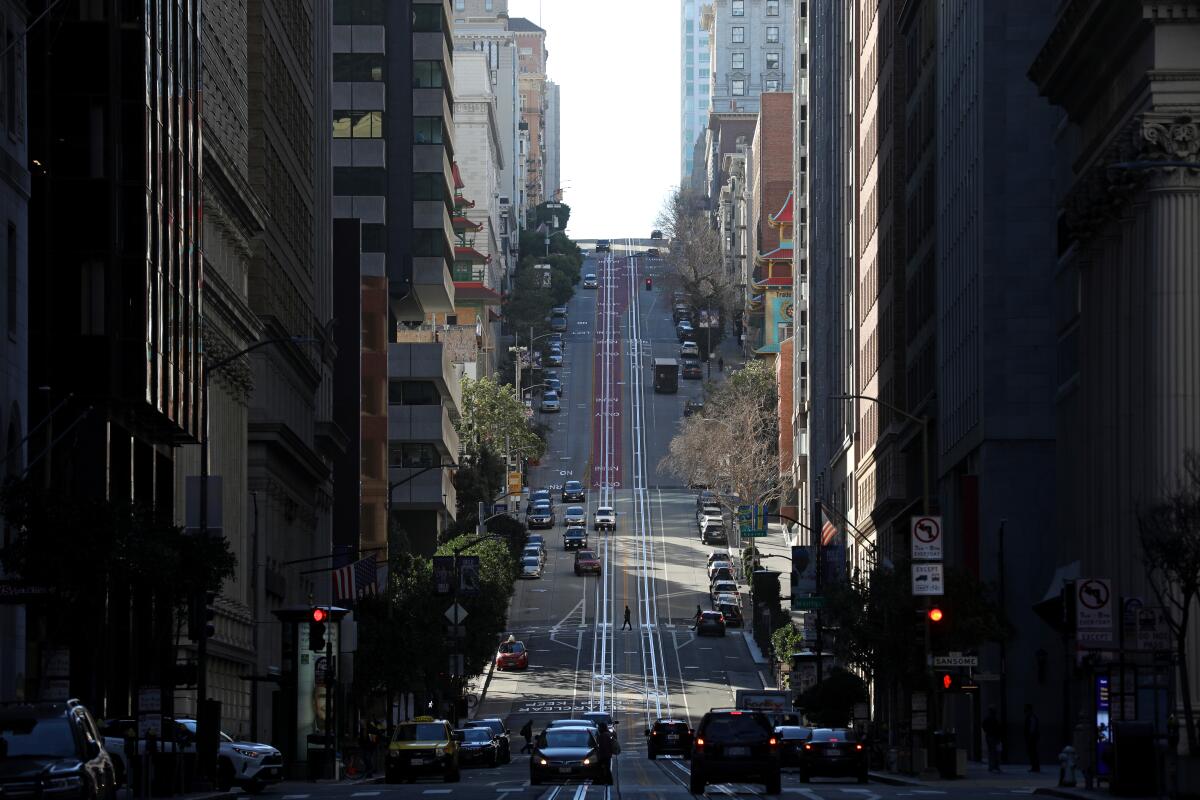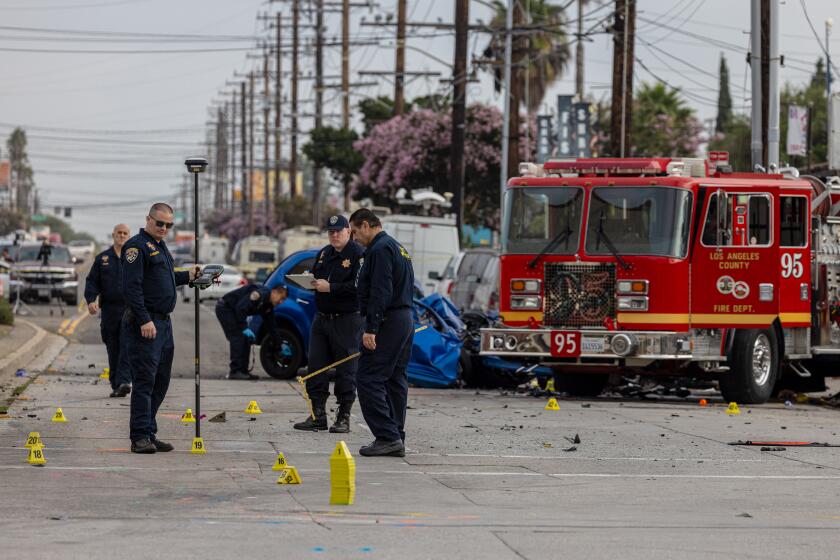San Francisco could ban right-hand turns on red. Could L.A. soon follow?

- Share via
San Francisco could soon ban right-hand turns on red lights, making it the second-largest city in the country to adopt the traffic rule.
The proposal, supporters said, could make the roads safer for bicyclists and pedestrians, encourage more people to walk, and cut down on the number of serious injuries in car accidents.
“Allowing turns on red results in deaths, injuries and collisions, as well as cars blocking or driving through crosswalks, making it more dangerous and stressful to cross the street,” said San Francisco Supervisor Dean Preston as he introduced the measure last week at a Board of Supervisors meeting. “We should be expanding no turn on red to every neighborhood.”
Advocates for pedestrian safety have applauded the resolution, saying the proposed law could have a significant effect on reducing the number of pedestrians who are seriously injured by cars. Although some advocates said they were hopeful San Francisco would institute the rule, which New York previously adopted, the chances of a similar measure taking root in Los Angeles are slim, at least for now.
Orange County prosecutors weigh whether to charge the Los Angeles County sheriff’s deputy implicated in a Mission Viejo car wreck that killed two Marines.
L.A. is “so car-centric” that people would think it was “the end of the world if we tried to implement this in Los Angeles,” said Damian Kevitt, founder of Streets Are for Everyone, a nonprofit that pushes for safety improvements for pedestrians, bicyclists and drivers.
In Los Angeles, advocacy groups have pushed to hold pedestrian-friendly events to get across to the public the need to walk more and drive less, as well as advocating for lowering speed limits on some streets and other measures to improve safety. But even the most ardent supporters are doubtful that a push to ban right turns on red lights would gain any traction in the county, at least for now.
“This is something that’s going to take years of work to even get to the point where it would be considered in L.A.,” Kevitt said.
Drivers in San Francisco, on the other hand, have already gotten a taste of what a ban on right-hand turns would look like.
Two separate vehicle crashes left three people dead in the San Fernando Valley this week. Two of the victims were in wheelchairs.
In the fall of 2021, San Francisco banned right-hand turns on red lights in more than 50 intersections of the Tenderloin neighborhood.
According to an early assessment of the program from the San Francisco Municipal Transportation Agency, the ban reduced the number of “close calls.”
The agency found that about 92% of vehicles were observing the rule, and the number of cars blocking crosswalks during a red light decreased by 70%.
After the initial program, SFMTA recommended expanding the rule to business districts. Preston’s resolution asks the agency to look at the possibility of expanding it across the city.
“It’s an important step in the right direction,” Preston said during the board meeting. “It’s a step we need to take in the city.”
Preston’s resolution comes after a 4-year-old in a stroller was killed in August by a driver making a right-hand turn on a green light at the intersection of 4th and King streets.
The tragedy raised questions about pedestrian safety at that intersection and citywide. Shortly after the incident, San Francisco Mayor London Breed called on SFMTA to identify changes that could be made to the intersection, including removing one of its two right-turn lanes, and changing the traffic signal to show a yellow arrow, instead of a green light, to encourage drivers to yield to pedestrians.
According to one study by Jerry, an insurance comparison company that drew on data from the National Highway Traffic Safety Administration, the number of pedestrians killed in car crashes reached a four-decade high across the country in 2021, reaching more than 7,000 people.
Car that crashed into firetruck in Compton was being chased, not racing, says family of woman killed
A speeding car that hit a firetruck near West Compton, killing a man and a woman in the car, was being chased by the man’s ex-girlfriend, according to the woman’s family.
Another study, from Streets Are for Everyone, found that in the city of Los Angeles there were 159 pedestrians killed in car crashes in 2022, a 20% increase when compared with 2021.
In San Francisco, the city in 2022 saw 39 traffic deaths, including 20 pedestrians killed — the highest number of fatalities in 15 years.
San Francisco and Los Angeles chalked up those alarming numbers despite adopting Vision Zero, a commitment from city officials to eliminate traffic deaths by 2025.
Officials have taken steps to reduce the number of fatalities. In February of last year, the Los Angeles City Council approved a plan to reduce speed limits on 177 miles of road by 5 mph. According to the Los Angeles Department of Transportation, the project is underway.
Excessive speed is a leading factor in collisions, advocates said.
City officials also have pushed for more pedestrian-friendly events in recent years, such as CicLAvia, as a way of promoting walking and urging residents to drive less.
But taking up a fight to ban right turns on red lights in Los Angeles would be an uphill fight, advocates said.
“Our city is moving in that direction,” said John Yi, executive director of Los Angeles Walks, a nonprofit that works with communities of color to advocate for pedestrian-safe infrastructure. “Is there a chance for this? I think so. But is it going to be easy? I don’t think so.”
Advocates, including Los Angeles Walks, have considered seeking this ban in Los Angeles but have decided to focus on other efforts that they believe could have a more significant effect, Yi said, such as reducing speed limits.
“Any time you try to restrict movement of cars, you have an entrenched electorate that pushes back on that,” he said. “But this is part of a larger ecosystem of changes that need to happen.”
There are some signs of change. In West Hollywood, for example, city officials are looking at a plan that would ban right-hand turns at red lights at the city’s busiest intersections.
“The county as a whole may not be ready, but there should be places where this isn’t a debate anymore,” said West Hollywood Councilmember Chelsea Lee Byers, who proposed the plan.
City officials, at this early stage, haven’t heard opposition to the idea, she said, which she credits in part to the city’s small, pedestrian-friendly size and measures it has already taken to encourage walking.
Still, she agrees that implementing a similar rule countywide would be a challenge.
“It completely speaks to the challenges of breaking through car culture,” she said. “It’s why I see West Hollywood as part of that leadership of mobility justice,” she said, referring to a movement to make streets safer for pedestrians and public transit more accessible.
The city expects to see a report on the measure from city staff and a consulting firm by next year, and she said she hoped the city would extend the proposed ban to other intersections in the future if the level of traffic at those sites increases.
Byers, who said she hadn’t owned a car herself in seven years, said she’d seen firsthand the need for such a measure.
“My right of way as a pedestrian is often challenged by vehicles,” she said. “I’m jealous of San Francisco.”
Right-hand turns on red lights came to be through the 1975 Energy Policy and Conservation Act, Kevitt said, which required states to allow the turns to receive federal funding.
Although the practice has never been found to reduce emissions or gas consumption, the measure was adopted as a way to cut down on idling cars at red lights during the 1970s oil crisis.
“But what we do know is that pedestrians are the ones that are most being hit and killed in traffic violence,” Kevitt said.
It could be a while before a similar measure could be viable in L.A., but Kevitt said it’s time the idea is considered. Smaller cities, such as West Hollywood, would be a start, he said.
“The right to drive is considered more senior than the right to live,” he said. “That needs to change.”
More to Read
Sign up for Essential California
The most important California stories and recommendations in your inbox every morning.
You may occasionally receive promotional content from the Los Angeles Times.
















